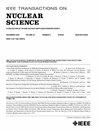基于数字光处理的3d打印辐射探测塑料闪烁体的研制与表征
IF 1.9
3区 工程技术
Q3 ENGINEERING, ELECTRICAL & ELECTRONIC
引用次数: 0
摘要
3D打印技术的出现为生产复杂的塑料闪烁体几何形状提供了一种有效的方法,降低了成本和制造时间。在本研究中,采用基于数字光处理(DLP)的3D打印技术制备了高芳香族含量的塑料闪烁体。分析了2,5-二苯氧恶唑(PPO)浓度和不同丙烯酸共聚单体对其衰减时间、光输出和脉冲形状识别(PSD)的影响。所制备的闪烁体比EJ-200和市售的psd塑料具有更好的定时特性。在含有30%PPO的样品中,EJ-200的光输出可达70%,PSD值(FoM)为1.55。由于内部散射减少,印刷更厚的单个层增强了光输出,而表面抛光的影响最小。稳定性测试表明,在六个月内,光输出下降不到5%,表明持续使用的潜力。本文章由计算机程序翻译,如有差异,请以英文原文为准。
Development and Characterization of Digital Light Processing-Based 3D-Printed Plastic Scintillator for Radiation Detection
The advent of 3D printing technology has provided an efficient method for producing complex plastic scintillator geometries, reducing both costs and manufacturing time. In this study, high-aromatic content plastic scintillators were fabricated using digital light processing (DLP)-based 3D printing. The effects of 2,5-diphenyloxazole (PPO) concentration and various acrylic co-monomers on decay time, light output, and pulse shape discrimination (PSD) were analyzed. The fabricated scintillators showed better timing characteristics than EJ-200 and commercially available PSD-capable plastics. Light output of up to 70% of EJ-200 was achieved in samples with 30%PPO, and a PSD figure of merit (FoM) of 1.55 was demonstrated. Light output was enhanced by printing thicker individual layers as internal scattering was reduced, while surface polishing had minimal effect. Stability tests showed less than 5% degradation in light output over six months, indicating potential for sustained use.
求助全文
通过发布文献求助,成功后即可免费获取论文全文。
去求助
来源期刊

IEEE Transactions on Nuclear Science
工程技术-工程:电子与电气
CiteScore
3.70
自引率
27.80%
发文量
314
审稿时长
6.2 months
期刊介绍:
The IEEE Transactions on Nuclear Science is a publication of the IEEE Nuclear and Plasma Sciences Society. It is viewed as the primary source of technical information in many of the areas it covers. As judged by JCR impact factor, TNS consistently ranks in the top five journals in the category of Nuclear Science & Technology. It has one of the higher immediacy indices, indicating that the information it publishes is viewed as timely, and has a relatively long citation half-life, indicating that the published information also is viewed as valuable for a number of years.
The IEEE Transactions on Nuclear Science is published bimonthly. Its scope includes all aspects of the theory and application of nuclear science and engineering. It focuses on instrumentation for the detection and measurement of ionizing radiation; particle accelerators and their controls; nuclear medicine and its application; effects of radiation on materials, components, and systems; reactor instrumentation and controls; and measurement of radiation in space.
 求助内容:
求助内容: 应助结果提醒方式:
应助结果提醒方式:


